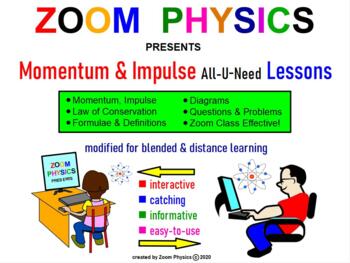Impulse Problems With Solutions
An impulse can act on an object to change either its linear momentum, angular momentum, or both. In many real life problems involving impulse and momentum, the impulse acting on a body consists of a large force acting for a very short period of time – for example, a hammer strike, or a collision between two bodies. This section provides materials for a session on unit step and unit impulse response. Materials include course notes, practice problems with solutions, a problem solving video, quizzes, and problem sets with solutions.
1. A ball with a mass of 100 grams is thrown horizontally at a speed of 5 m/s. Then the ball is hit in the same direction as the initial direction. If the time interval the ball in contact with the hitter is 2 ms and the speed of the ball after leaving the hitter is 10 m/s, then the force produced by the hitter is …
Known:
m = 100 gram = 0.1 kg
vo = +5 m/s
t = 2 milliseconds = 2 x 10-3 seconds
vt = +10 m/s

Wanted:
The force exerted by the hitter on the ball (F)?
Solution:
Equation of Impulse:
I = F t
Equation of the change of momentum:
Δp = m vt – m vo
Theorem of impulse-momentum:
Afterward, you need to launch the SKSE64.exe and not the Skyrim executable through Steam. Free skyrim mods for pc. I'm talking a better UI experience that wasn't designed for consoles, more feature-packed mods, and more.Just make sure you download and install the version for SE and not the old Skyrim. What this tool allows you to do is install mods that require additional functionality that the base game engine simply cannot offer.
Impulse = the change of momentum
I = Δp
F t = m vt – m vo
F t = m (vt -vo)
F (2 x 10-3) = (0.1)(10-5)
F (2 x 10-3) = (0.1)(5)
F (2 x 10-3) = 0.5
F = (0.5) / (2x 10-3)
F = 0.25 x 103
F = 250 N
2. A ball with a mass of 0.1 kg is thrown horizontally to the right at a speed of 20 m/s. After being hit, the ball moves to the left at a speed of 30 m / s. The impulse given by the wooden hitter on the ball is …
Known:
m = 0.1 kg, vo = +20 m/s, vt = -30 m/s
Wanted:
Impulse (I) ?
Solution:
Impulse = the change of momentum
I = m (vt – vo) = (0.1)(-30 – 20) = (0.1)(-50) = -5 N s
3. The 0.5 kg ball first moves to the left at a speed of 2 m / s. Then the ball is hit with the force F opposite to the motion of the ball so that the speed of the ball changes to 5 m / s. If the ball in contact with a hitter for 0.01 second, then the change of momentum is …
Known:
m = 0.5 kg, vo = -2 m/s, vt = 5 m/s, t = 0.01 second
Wanted:
The change of momentum
Solution:
The change of momentum = m (vt – vo) = (0.5)(5 – (-2)) = (0.5)(7) = 3.5 kg m/s = 3.5 N s
« Previous Next »
Session Overview
In this session we study differential equations with step or delta functions as input. For physical systems, this means that we are looking at discontinuous or impulsive inputs to the system. |
Session Activities
Read the course notes:
Check Yourself
Take the quiz:
Session Activities
Read the course notes:
Check Yourself
Take the quiz:
Session Activities
Read the course notes:
Check Yourself
Take the quiz:
Session Activities
Read the course notes:
Watch the problem solving video:
- Unit Step and Impulse Response (00:13:01)
Flash and JavaScript are required for this feature.
Flash and JavaScript are required for this feature.
Unit Step and Impulse Response
Complete the practice problems:
Check Yourself
Complete the problem sets:
« Previous Next »
Welcome!
This is one of over 2,200 courses on OCW. Find materials for this course in the pages linked along the left.
MIT OpenCourseWare is a free & open publication of material from thousands of MIT courses, covering the entire MIT curriculum.
Momentum Impulse Collision Problems With Solutions
No enrollment or registration. Freely browse and use OCW materials at your own pace. There's no signup, and no start or end dates.
Knowledge is your reward. Use OCW to guide your own life-long learning, or to teach others. We don't offer credit or certification for using OCW.
Made for sharing. Download files for later. Send to friends and colleagues. Modify, remix, and reuse (just remember to cite OCW as the source.)
Learn more at Get Started with MIT OpenCourseWare